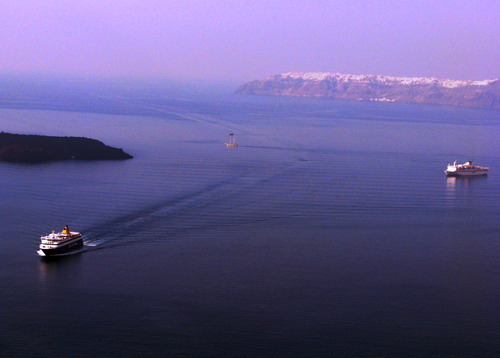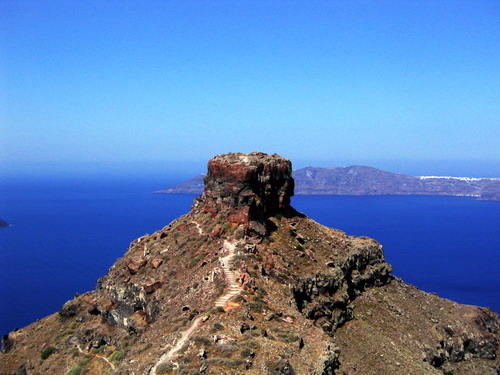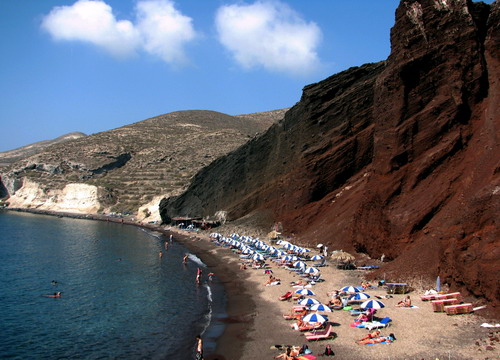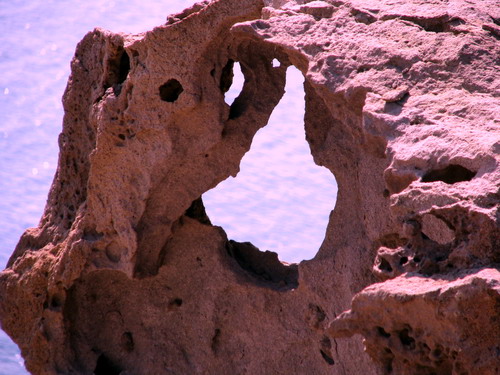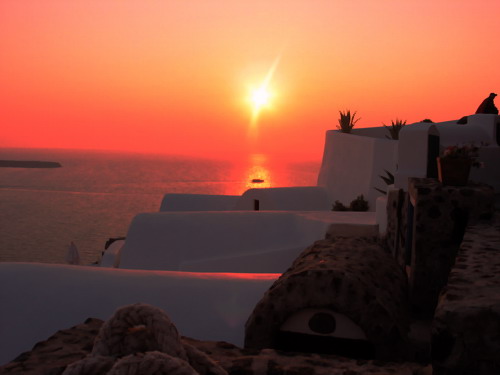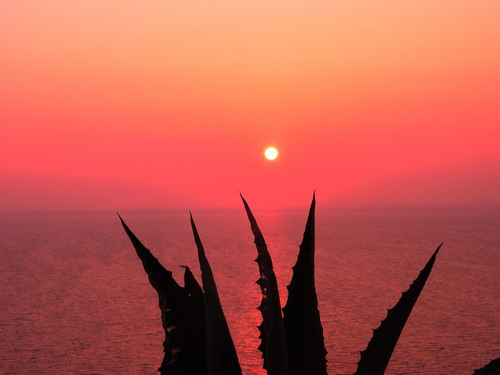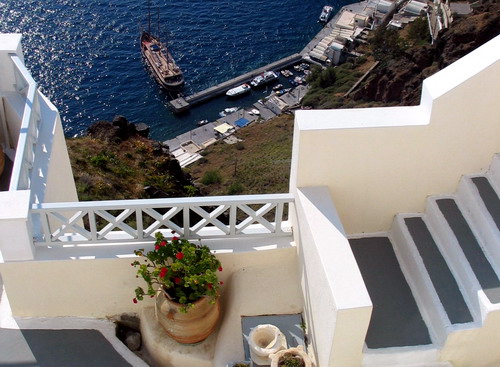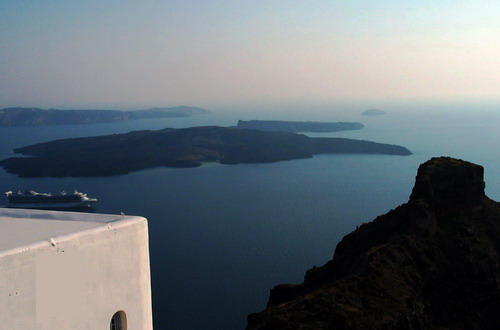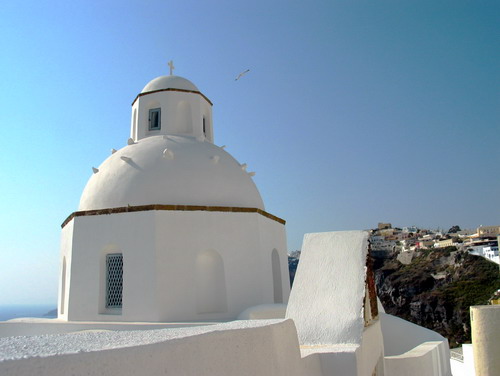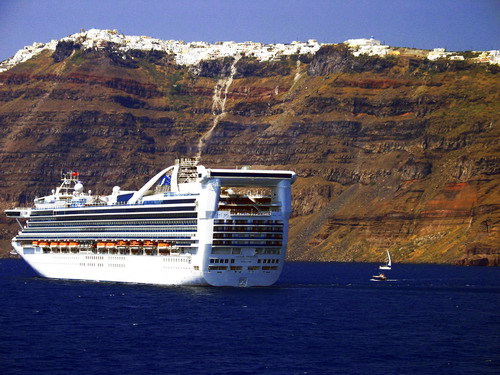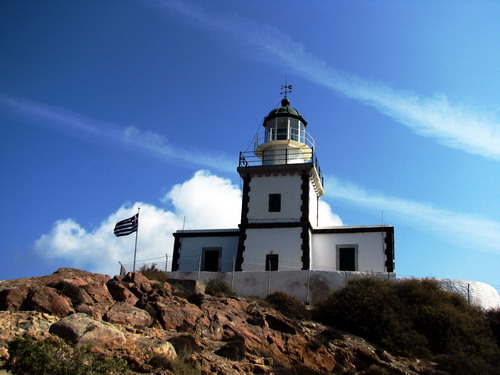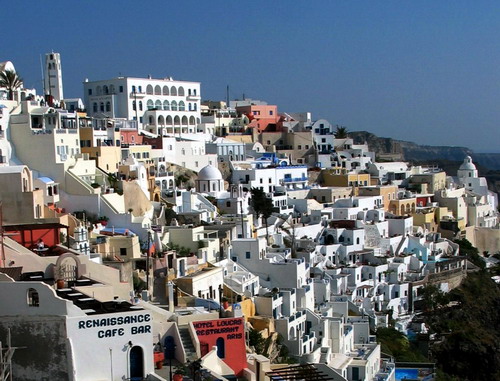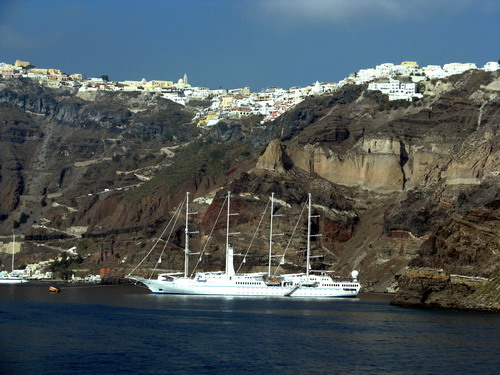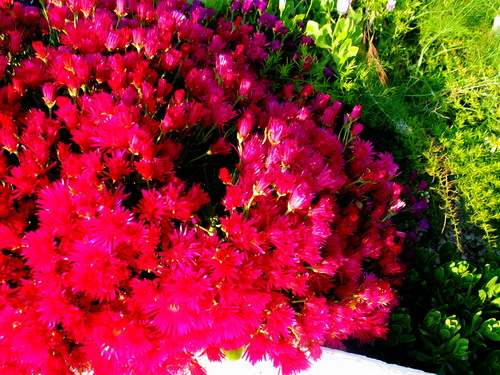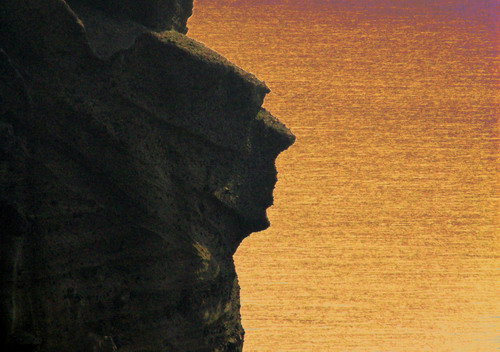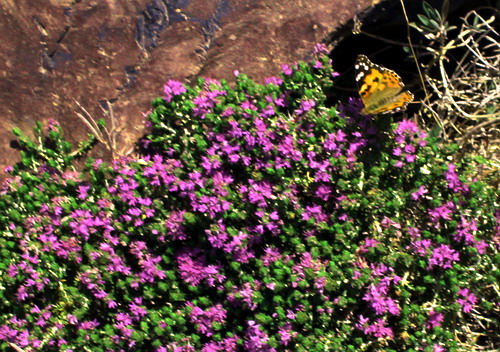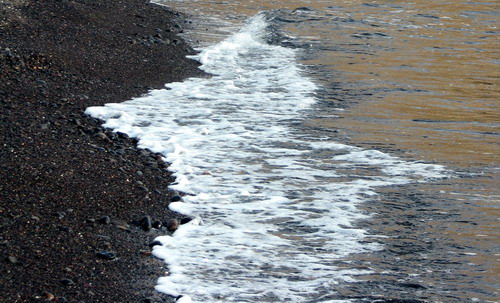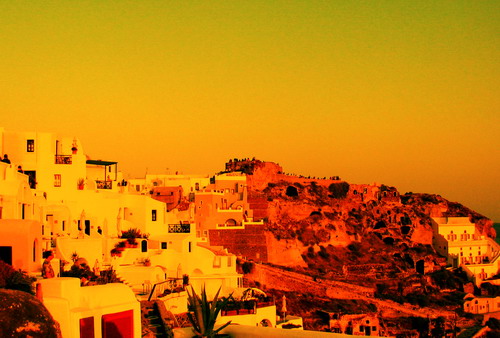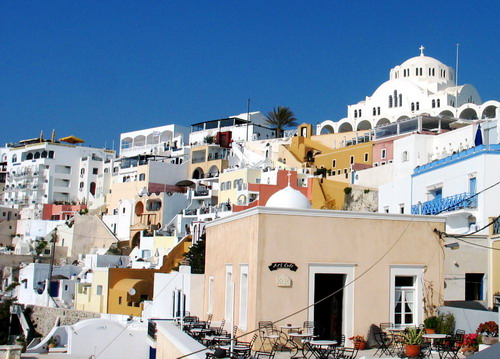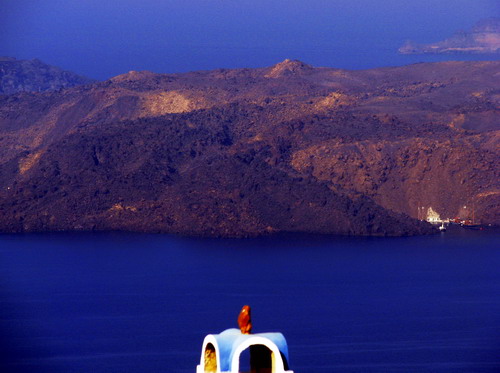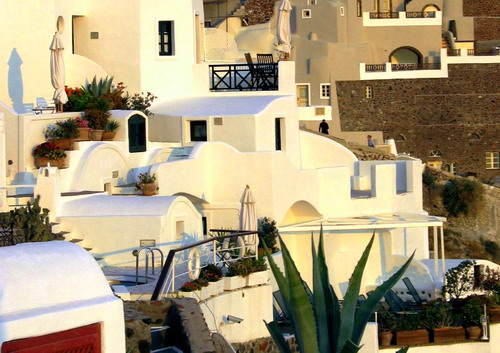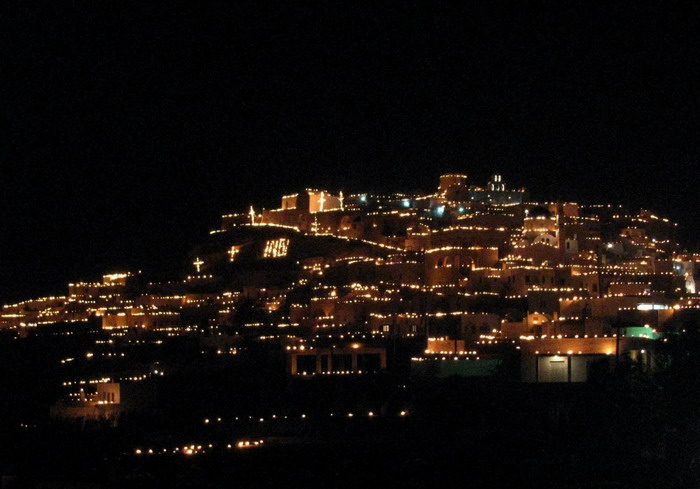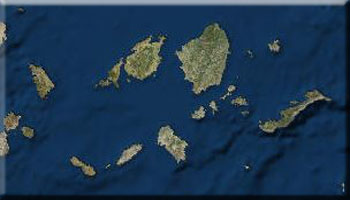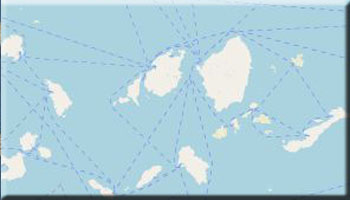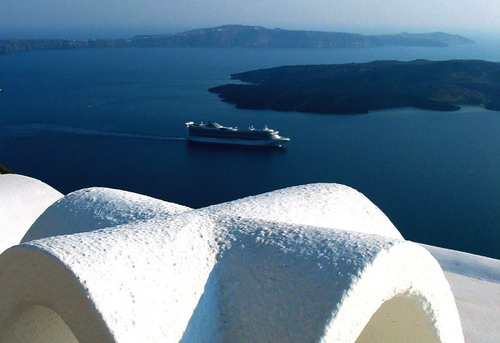 SANTORINI
SANTORINI
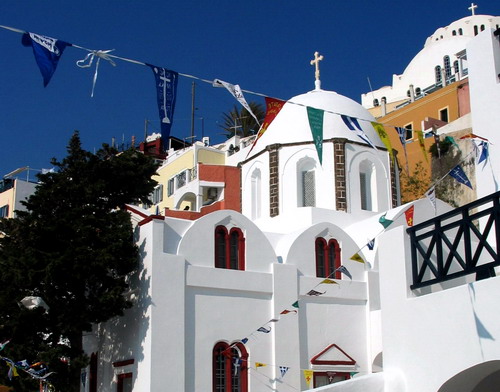 CHURCH IN FIRA
CHURCH IN FIRA
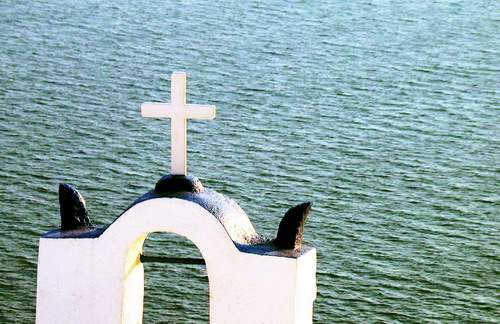 SEA VIEW
SEA VIEW
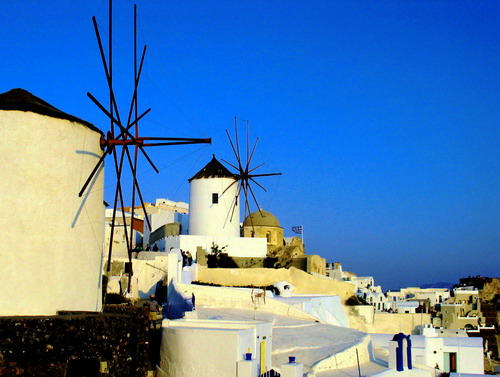 WINDMILLS IN IA
WINDMILLS IN IA
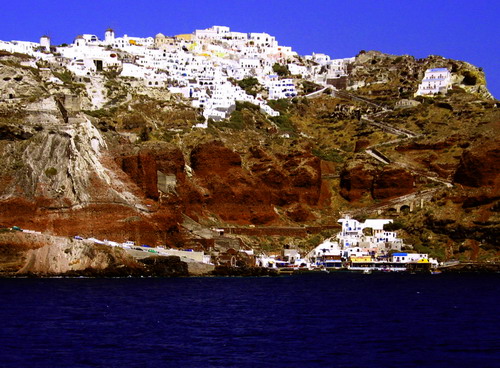 IA VILLAGE - AMOUDI
IA VILLAGE - AMOUDI
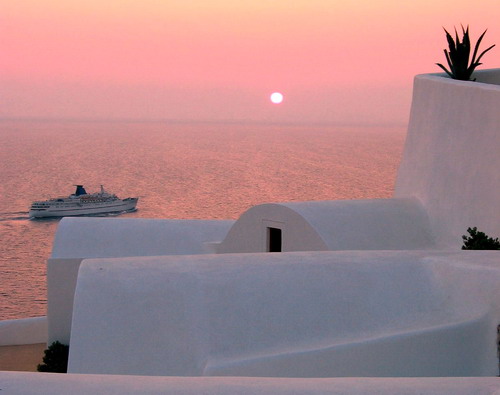 IA SUNSET - BOAT
IA SUNSET - BOAT
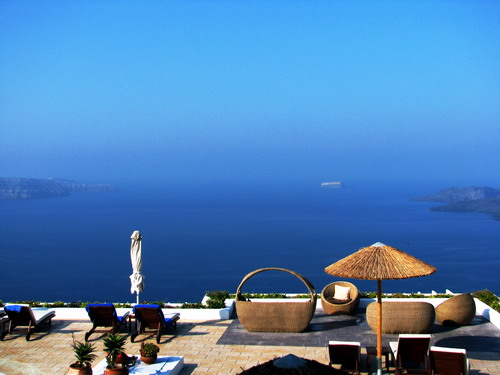 CALDERA VIEW
CALDERA VIEW
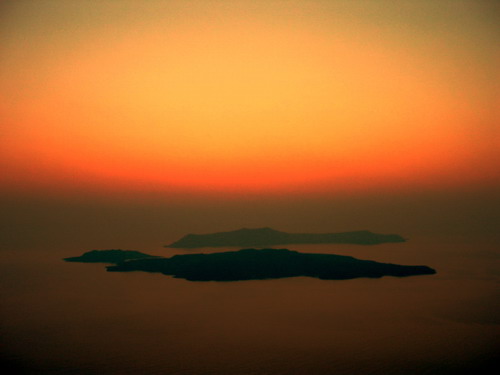 NEW & OLD KAMENI
NEW & OLD KAMENI
Santorini is the southernmost island of the Cyclades group. Its soil is volcanic and rocky at the end where the volcano is located. The island has a wealth of archaeology that includes the Ancient city of Mesa Vouno and the prehistoric settlement of Akrotiri.
Santorini's culture includes a unique vernacular architecture, best exemplified by the settlements of Vothonas, Messaria, Finikia, and Megalohori and the advanced fortified settlements of Pyrgos, Emporio, and Akrotiri.
The island's moderate climate is due to its exposure to northeasterly winds, while winters on the island are temperate with average temperatures in the region of 10oC. Rainy winters alternate with dry summers, and the fertile soil is ideal for the cultivation of vines and tomatoes. The island has meager freshwater resources and few wells.
Santorini has a population of 7,000 concentrated in roughly 10 villages. Fira, the capital, and Oia, one of the prettiest villages in the Cyclades, are renowned for their sunsets. The "black" beaches with the sheer cliffs and the volcanic soil add to the island's unique landscape.
Santorini offers air links to Mykonos, Rhodes, Iraklio (Crete), as well as Athens and Thessaloniki. By sea, it's linked to Piraeus and Thessaloniki, with connections to Paros, Ios, Mykonos, Anafi, Naxos, Sikinos, Syros, Kimolos, Kithnos, Milos, Serifos, Sifnos, Tinos, Folegandros, Astypalaia, Karpathos, Diafani, Kassos, Rhodes, Halki, Iraklio (Crete), Skiathos, Skyros, and Volos. There's also a hydrofoil connection to Rafina and all the above-mentioned islands.
Known in antiquity as Strongili because of its round shape, the island was transformed by a volcanic eruption in the 15th century during which its center sank, forming the caldera. The Phoenicians named the island Kallisti, or most beautiful, and the Dorians called it Thira.
The name Santorini dates from the 12th century and is a relic of Frankish rule when it was known as Santa Irini. Minoan culture flourished on the island until roughly 2000 B.C. when the island's development was halted by a volcanic eruption.
According to historical sources, the eruption darkened the entire Aegean, scattering ash and creating 250-meter high tidal waves that traveled with speeds of 300 kilometers per hour and washed away cities on Crete and Egypt. In some myths, Santorini is identified with the lost continent of Atlantis.
Thira came under Persian rule and later allied itself with Sparta, although in 426 B.C. it passed under the hegemony of Athens. It was subsequently conquered by the Ptolemies and later the Romans.
During the Byzantine era, Thira was a part of the Aegean Sea Province, or Thema, then later became part of the Duchy of Naxos before falling to the Venetians. The latter period is marked by the conversion of large segments of the population to the Catholic faith. In 1537, the island fell to Barbarossa's pirates and in 1579 was taken by the Turks. From 1770 to 1774, it was under Russian rule and in 1832 became a part of the newly formed modern Greek state.
| General: |
| Nea and Palaia Kameni |
| The volcano |
| The island's Wineries |
| Fira: |
| The archaeological Museum |
| The Folklore Museum |
| The two Orthodox and Catholic Cathedrals |
| The Dominican Convent |
| The Venetian-era Cultural Centre "Megaro Gyzi" |
| The Caldera |
| Akrotiri: |
| The ruins of the Minoan City |
| "Kastelli", the Venetian Castle - a typical fortified settlement |
| Emporio: |
| The square "Goulas" Tower |
| The windmills |
| The "Kastelli" Castle |
| Imerovigli: |
| Ayios Nikolaos Monastery |
| Skaros, the Venetian \Castle |
| The Caldera |
| Kamari: |
| The ruins of Ancient Thera |
| Oia: |
| The Castle |
| The windmills |
| The Naval Museum |
| Perissa: |
| The site of Ancient Thera |
| Katefiani |
| Ayia Irini |
| Pyrgos Kallistis: |
| Profitis Ilias Monastery |
| The Kastelli - Ecclasiastical Museum |
| The "Proseismikos Pyrgos" Folklore collection |
| Mesaria: |
| The Aryirou Mansion |
| Finally, you should also visit: |
| The Art Space Museum at Gonia |
| The Volcan Wines - Wine Museum at Vothonas |
Akrotiri: Kokkini (red) Beach, Aspri (white) Beach, Mesa Pigadia, Apothikes, Kambia
Emporio: Perissa, Perivolos, Ai Yioryis, Exomytis, Vlyhada
Kamari (Blue Flag): Kamari, Mavri (black) Beach
Monolitho: Monolithos
Oia: Ammoudi, Armeni, Baxedes, Kouloumbos, Pori
Reenactment of the volcanic eruption: In late August, the Municipality of Thira organizes a recreation of the volcanic eruption with a fireworks display followed by a concert featuring prominent Greek artists.
"Halaria": Sports competition in memory of the local athlete Emmanuil Halaris.
Traditional Wedding: During summer, Akrotiri organizes a mock traditional Santorini wedding.
Good Friday: At the village of Pyrgos, locals ignite hundreds of tins stuffed with petrol-soaked rags as the Epitaphios is carried in procession through the village. The extraordinary sight is visible around the island.
The burning of the Ovrios: On Easter Sunday, many villages organize mock popular courts that sentence to death, and then burn in effigy, the Ovrios (a rag doll in human form).
Paniyiria: Santorini is renowned for its paniyiria, folk festivals combining the observance of religious feast days with a communal feast featuring food, wine, and music. Islanders are faithful in their observance of these customs, which is in keeping with their devotion to the church and its traditions. Some of the most popular paniyiria are listed below:
- Feast of Sotiros at Pyrgos: According to custom, youths steal potted basil plants from the gardens of households with young women and use the plants to decorate the church yard.
- Ayios Yioryis "Sfouggatas" at Firostefani: Local tradition holds that the saint wished for his feast to be observed with the preparation and sharing of the kamponosfouggato, an omelet made with kampounes and other wild greens.
- "Ayioi Eftapedes": Located on the caldera's rim about midway between Imerovigli and Oia, this small chapel is only accessible by boat.
- On the feasts of Panayia Myrtidiotissa at Kamari, Panayia Platsani at Oia, Stavros at Emporio, Profitis Ilias, and on the Assumption of the Virgin on August 15, folk festivals are organized after religious services with food, wine, and dancing.
| MUNICIPALITY OF THIRA | 2286022231 |
| CITIZENS SERVICE BUREAU (KEP) | 2286360123 |
| HOSPITAL | 2286035300 |
| HARBOR POLICE | 2286022239 |
| POLICE STATION | 2286022649 |
| FIRE STATION | 2286033199 |
| AIRPORT | 2286028400 |
| TAXI STATION | 2286022555 |
| BUS STATION | 2286025404 |
| INFORMATION CENTRE | 2286025940 |









